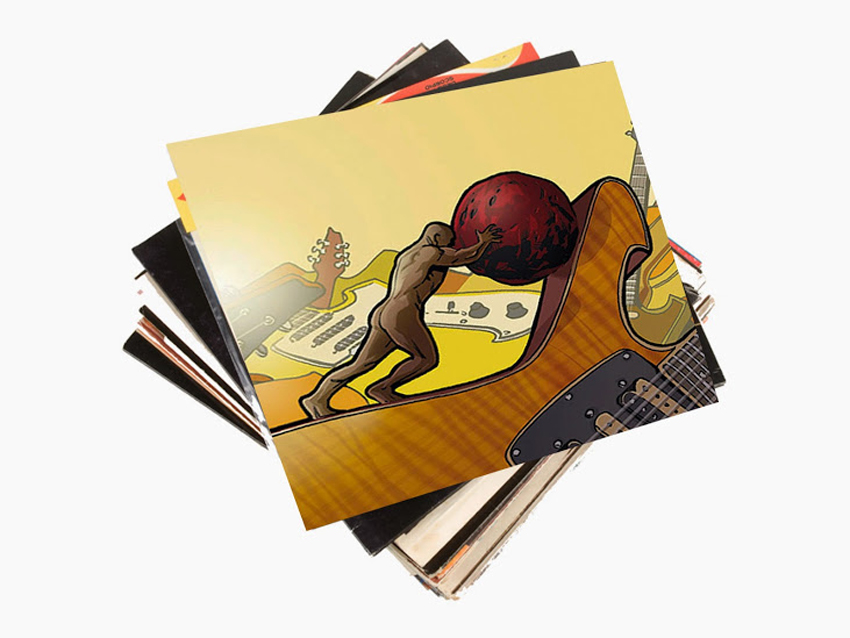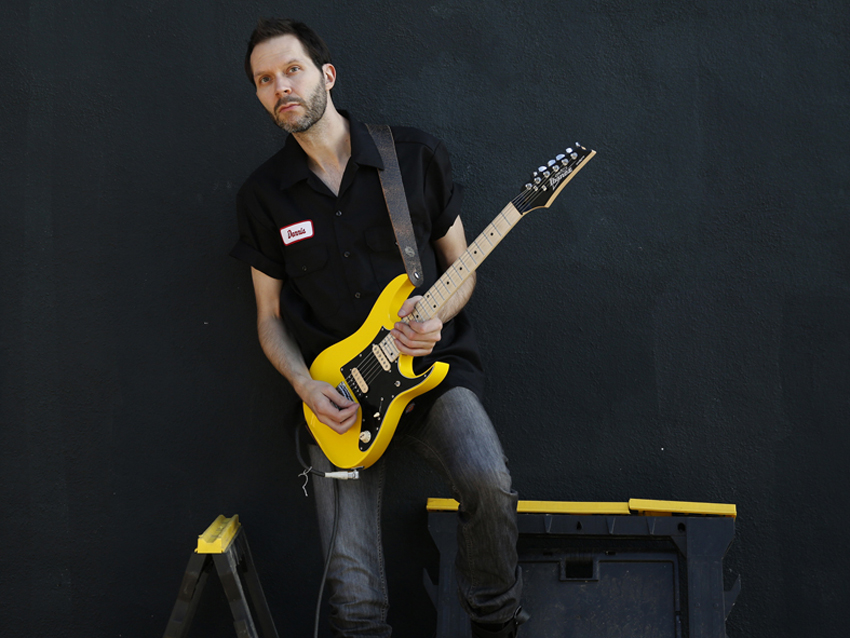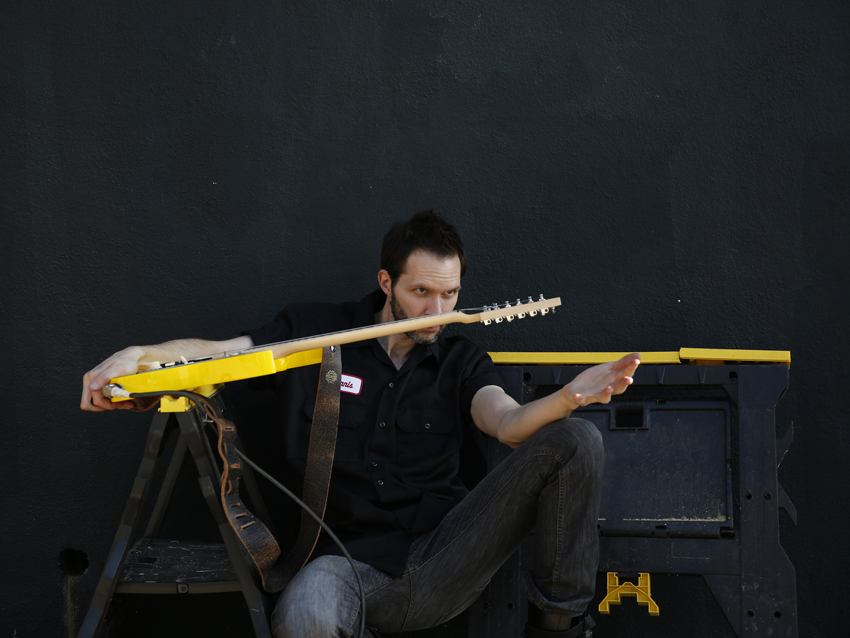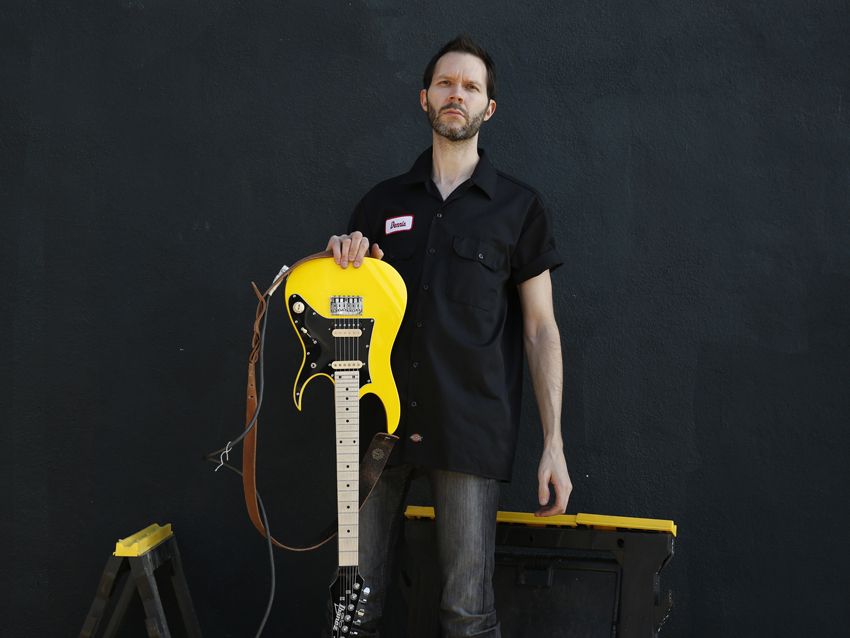
Paul Gilbert talks Stone Pushing Uphill Man track-by-track
On Paul Gilbert's wickedly smart and deliriously entertaining new album, Stone Pushing Uphill Man, the guitar virtuoso tackles eight cover tunes and pays homage to as many of his vocalist heroes – a diverse group, everyone from James Brown Reno to k.d. lang – by channeling their singing styles and personas through his axe.
It's an altogether impressive feat, brimming with real bravado, one in which Gilbert's craftsmanship, to say nothing of his pure musical joy, is remarkably sustained. But the funny thing is, the record didn't start out that way at all. "Actually, the first song that I wrote for the album was an original, Purple Without All the Red, but that song scared me," he says. "It was kind of a slow blues with some really unusual chords. I thought that if I kept going in that direction, I’d put my rock fans to sleep."
To shake things up, the guitarist recorded a version of the 1981 Loverboy hit Working For The Weekend, "and that got me rocking again," he says. “I did one cover, and I couldn’t stop. Finally, towards the end of recording, I felt better about putting my jazzy tune on the record, because it was a nice contrast to all the rock.” Two more originals round out the record, the madcap funk-rock romp Shock Absorber along with the set-closing title track, an extravagant blues/gospel benediction on which Gilbert's hallmark shred skills are counterbalanced by a boisterous, multi-tracked vocal choir that could stir the deadest of souls.
Gilbert sat down recently to talk to MusicRadar about the recording of Stone Pushing Uphill Man, and on the following pages he walks us through the album track-by-track. (You can order the album at iTunes, Amazon or Shrapnel Records.)
Your singing is terrific on the title track. Did you think at first about doing any – or all – of the songs vocally? What were the challenges of transposing the songs to strictly guitar melodies?
“That’s nice of you to say, and sometimes I surprise myself by singing well. But I also sometimes try to sing songs that are out of my range, and I screw them up. The title track, Stone Pushing Uphill Man, is nice and low, so I can relax and enjoying singing it. I actually wrote complete lyrics for another song on the record called Shock Absorber, but after singing it once, I decided to play the melody on guitar. It sounded much better to me, so that’s how it ended up.
“It was very challenging to play so many vocal melodies on guitar. A good vocalist tends to use a lot more expressive elements than guitar players typically do, or at least guitarists like me, who are known for all those scales going up and down. But that challenge is exactly what I wanted. I love the sound of bending, sliding, vibrato and dynamics, and squeezing harmonics out the strings and leaving space – trying to phrase like a vocalist. This album was an amazing guitar lesson for me.”
How does performing and recording cover tunes help stretch you as an artist? Some musicians try to shy away from covers.
“I learned to play guitar by playing cover tunes. Songs have always been my best teacher. I did go to a great music school for a year, and I learned the usual list of scales, arpeggios and chords. But that stuff makes a lot more sense to me when I hear how it’s used in a Beatles tune. I did a Beatles tune, Why Don’t We Do It In The Road, on this album. It’s basically a blues song, with Paul McCartney singing as dirty as he can.
"I’ve been working on my blues playing a lot for the last few years, but every phrase of this vocal line had something in it that I hadn’t played before. In the past, I’ve tried to play solos by ‘visualizing’ scale shapes. But now I can get inspiration by visualizing vocal styles. If I bring Paul McCartney to mind, it’s going to inspire me to play differently than if I think about James Brown. And both will inspire me to play differently than if I think about scale patterns.
“The thing that I realized is that my head is full of the vocal melodies that I grew up listening to. I can hum them easily, but I can’t play them easily. It requires a different approach to the guitar than what I usually play. But this is why I love it: Every time I learn a vocal line, my guitar playing expands so much. I want to connect my fingers with the melodies in my head. I can’t believe that it took me so long to finally start trying to do this.”
You've got two drumming heavyweights on the record: Mike Portnoy and Kenny Aronoff. Now, you've worked with Mike Portnoy before, but I've never heard you with Kenny until now. How would you describe their differences as players and how they approached the material?
“Mike just always sounds like he’s having fun, and I think that’s probably because he is. Mike and I are close in age, and we grew up listening to a lot of the same music, so I knew that he could appreciate the ‘seriousness’ of the Loverboy track, and the depth of Ringo’s drumming in a Beatles song. Mike struck a great balance between playing the original grooves and throwing in some lightning bolts of his own drumming style.
“This was the first time that I worked with Kenny, and he was fantastic. I threw radically contrasting styles and grooves at him, and he played each one with passion and authority. A song like Back In The Saddle requires some primitive ‘caveman’ grooves, while Murder By Numbers has sophisticated displaced accents. And a song like Eric Carmen’s My Girl is surprisingly demanding on a drummer. The parts are very specific, and it takes a master of shuffles to get the feel right. And then there’s the James Brown tune; that’s a tune that requires both speed and funk, and Kenny kept it all glued together. He also improvised really well with my already-recorded guitar solos, and made them sound like we were jamming together live.”
Were there any songs that you attempted but they just didn’t feel or sound right for whatever reason?
“There were a lot of songs that I would have liked to do. I worked up short versions of Fire And Ice by Pat Benetar, Long Live Rock And Roll by Rainbow, Tutti Frutti by Little Richard, Fly By Night by Rush and Running With The Devil by Van Halen. I love the part where David Lee Roth sings, ‘Goddammit woman, I ain’t lyin’ to you. I’m only gonna tell ya one taa-ime AHHHHHH AAAAHHHH!!!!’ Most of that line is just a single note, but Dave puts so much style into that thing. If I can make my guitar do that, I’ll have really accomplished something.
“The only song that I tried that I thought I should stay away from was Papa Don’t Preach by Madonna. I love the song, but even if I did it instrumentally, I think that people who know the lyrics might feel strange to have a guy singing it, even with a guitar. I mean, if I did an instrumental version of You Make Me Feel Like A Natural Woman, would it be OK? I guess if these are my problems, life is pretty good.”

Working For The Weekend
“Loverboy saved my ‘80s rock spirit with this song. I was all set to record a sullen blues album, and after covering this, I was ready to rock. The vocal line was very demanding. I actually recorded the whole thing, and then scrapped it and started over – it needed more energy.
“You really have to hit the strings and rock out. While I was recording the chorus melody, the part that goes, ‘Every-body’s work-in’ for the...’ I realized that the melody is almost identical to the verse in Katy Perry’s Teenage Dream. It’s a simple and repetitive melody, but to make it sound convincing on guitar took me hours of experimenting with different fingerings and techniques.”

Back In The Saddle
“I found an ‘isolated’ guitar mix on YouTube, whichmade it much easier to hear all of those parts that answer the vocal. I approached them as a purist and really tried to play them authentically.
“The only part where I improvised was the end of the song. The wobbly part is actually a six-string bass, double-tracked. And for Steven Tyler’s super-high screaming parts, I used an old Ibanez that has a Fernandes Sustainer in it.”

I Got The Feelin'
“I just love the intro, where James sings ‘Baby, baby, baaa-by. Baby, baby, baaa-by. Baby, baby, baaa-by. I have students and fans who will try to impress me by playing complicated tunes like Technical Difficulties or Scarified, but I’d be much more interested in hearing how they handle something like this.
“And in the verse, James Brown’s phrasing is so quick and locked into the groove. I recommend trying to play this song to any guitar player – you will learn things about yourself. And you’ll learn things about James Brown, mainly that The Godfather Of Soul was not a title easily earned. But certainly it’s fun trying to do some moves in those shoes.”

Goodbye Yellow Brick Road
“The orchestration is pretty much what is happening on the Elton version, except I put it together with all guitars. I used the Sustainer again and just wrote out the individual notes of all the chords, and I layered them one line at a time. The backbone of the tune is Elton’s piano, which I changed to a Little Wing-ish guitar part. And I double-tracked all the main melody parts to get a similar feel to Elton’s double-tracked vocal.
“I really felt that, for my purposes, the song needed some kind of guitar solo. I wrote a part that’s sort of a Van Halen-y version at the end of Bold As Love by Hendrix, and I just played as angrily as I could over it while still navigating through the chord changes. Kenny’s drumming helped glue my new part to the original song and make it work.”

Why Don't We Do It In The Road?
“This song is just dirty. And it’s nice to hear that from a master of pop melody like Paul McCartney. I mean, Celine Dion will probably never record Loveshit by The Wildhearts. I doubt if she would consider getting dirty like that. But Paul wrote a great dirty song, and that’s cause for celebration.
“Since I’ve been studying blues lately, I’m always interested to see how improvisers treat each chord. And I love the way that Paul sings, ‘No one will be watching us’ over the V chord. I’m stealing that one.”

Shock Absorber
“The intro is from a blues harmonica instructional DVD by Rick Estrin. You’ve probably heard of Aristotle, Plato and Socrates, and to me, Rick Estrin stands among the greats when it comes to musical philosophy.
“I took that bit from where he’s describing a performance technique he calls ‘The Look.’ Rick suggests that you play a musical phrase of suitable depth, then pause, and then look at the audience with an expression that says, ‘That’s the most important shit you’re ever gonna hear in your life.’ If you know that you’re going to use that look on an audience, it does obligate you to play some notes that matter.
“Anyway, my song did originally have vocals. I wrote three verses and a couple of B sections for it, and I even sang it once. But in the spirit of my album, I thought I’d try playing the vocal on guitar, and it just immediately sounded better. The seed of the groove came from thinking of a riff to teach one of my students at my online school. I liked the groove so much that I saved it for my song. I’m also proud of the notes in the ‘fusion’ part. I used some outside stuff, and it came to me by ear, which is always the best way for music to happen.”

Purple Without All The Red
“I had just bought a new Leslie simulator pedal, a mini Vent, and it gave the song some character that I thought it needed. The writing came very naturally. I had been listening to a Nina Simone song called Chilly Winds, and I noticed that the blues chord changes were different than what I usually hear. It inspired me to start the song the way a typical blues would start but then take it to some unexpected places.
“I used a lot of unusual chord inversions, but they still sounded right to me. The last chord before it repeats is an E7/G. This is actually an inversion of the ‘Hendrix chord,’ the E7#9. The #9 in the key of E is F##, which is the same sound as a G note. That note is usual played as the highest note in the chord, but I played it as the lowest note. It gives it a very different character. I did all of that music theory labeling after the fact. I found the chord by ear."

Murder By Numbers
“I heard this on the radio when I was a kid – enough times to remember it and like it. Speaking of chords, the second chord in this tune is an Fsus/A. It’s really dissonant, and really great. I tried to use the notes of that chord to build an arpeggio that I could use for the solo. It worked great, but I don’t know when I can use it again, as I don’t know any other songs that have this chord.
“That’s Kenny Aronoff on drums. He stayed true to Stewart Copeland’s playing in the main parts of the song, but at the end he lets loose in my solo. I listened to the original Sting vocal a lot, to try to get the phrasing right. When I would play it from memory, I would tend to play it more like a guitar player and not ‘breathe’ so much. But a real singer has to breathe. And when I dug deep into Sting’s performance, I could see where he was taking breaths, and I tried to follow with my guitar.”

My Girl
“Well, first of all, let’s give some credit to Rachmaninoff, the classical composer. Eric Carmen borrowed several of Rachmaninoff’s melodies to write the hit songs All By Myself and Never Gonna Fall In Love Again.
“The song My Girl is from the same record. Eric begins with a Rachmaninoff theme and uses it for the bridge of the song, as well. I’ve got no problem with borrowing from the greats. And I must admit that I heard Eric’s versions many times before I finally stumbled on the original Rachmaninoff melodies.
My Girl’s changes remind me of Pet Sounds-era Beach Boys. Slash chords and modulations are everywhere, with lots of surprising notes at the ends of phrases. I love this stuff. It is to pop songwriting what Yngwie is to guitar playing – absolutely over the top. I hope people dig my version, but I also hope they’ll go back and listen to the original Eric Carmen version. It’s a pop masterpiece.”

Wash Me Clean
“I’ve been a huge k.d. lang fan since I first heard her in the early ‘90s. When the rock scene turned to grunge, I turned to female singers. I got into k.d. lang, Chaka Khan, Wendy and Lisa, Janet Jackson, and Mariah Carey. Somewhere I’ve got a demo where I tried to cover Best For Last by Vanessa Williams. I covered Escapade and Come Back To Me by Janet Jackson, as well.
“Those were demos where I was pushing the boundaries of my falsetto, and the result was something that definitely falls in the ‘experimental’ category. But I’m happy with what I could do with my guitar on the kd lang tune.
“The keyboards that you hear are actually all guitars. I built the walls of chords one note at a time and then soaked them with some reverb. The acoustic is the guitar that I call The Hitmaker. It’s an all-Koa Taylor that I used to record To Be With You by Mr. Big. The electric solo is my new Ibanez Fireman, the FRM250MF. It’s got a thick neck with lots of tone and resonance.”

Stone Pushing Uphill Man
“I love Todd Rungren, and one of his more gospel-y tunes changed my life. It’s a song called Hawking, and when I saw him play it live, I found myself sobbing with emotion for about six minutes straight.
“That experience made me realize the power of vocals and songwriting – and how the guitar isn’t always the most important thing. It’s taken me two decades to think that the guitar might be able to do what a vocalist can do. Maybe the guitar can’t be exactly the same, but it can certainly benefit from taking some steps in that direction.
“Of course, my gospel-y tune is the only one where I sing on this record. It did start out as a few different song ideas, none of which felt complete to me. Suddenly, however, I realized that they could all fit together. The lyrics came to me quickly. I had been playing with the title for a few months, and I liked the purposeful wrongness of the grammar and the visual picture that it painted.
“The lyrics are just about feeling like you’ve lost something that you’ve worked hard for but then realizing that the work is what you love anyway. I feel a bit like that, when I look back at a lot of my old solo albums where I was trying to be a singer. I used to really like those albums and I’d listen to them a lot. Now, somehow I wish that I had just stuck to playing guitar. But I loved making those records. And I love what I’m doing now. That stone may roll down the hill, but I love pushing it. I can do it all day and have the best time.”
Joe is a freelance journalist who has, over the past few decades, interviewed hundreds of guitarists for Guitar World, Guitar Player, MusicRadar and Classic Rock. He is also a former editor of Guitar World, contributing writer for Guitar Aficionado and VP of A&R for Island Records. He’s an enthusiastic guitarist, but he’s nowhere near the likes of the people he interviews. Surprisingly, his skills are more suited to the drums. If you need a drummer for your Beatles tribute band, look him up.
